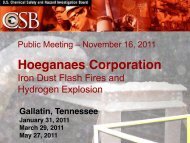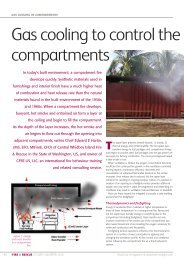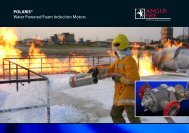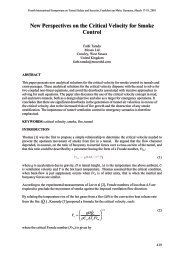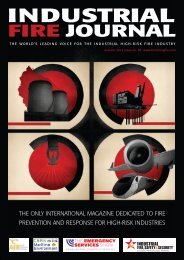to download in PDF format. - Industrial Fire Journal
to download in PDF format. - Industrial Fire Journal
to download in PDF format. - Industrial Fire Journal
You also want an ePaper? Increase the reach of your titles
YUMPU automatically turns print PDFs into web optimized ePapers that Google loves.
FOAM: CONFERENCE HIGHLIGHTS<br />
Foam<strong>in</strong>g with questions<br />
That the use of foam cont<strong>in</strong>ues <strong>to</strong> cause headaches<br />
for firefighters became obvious dur<strong>in</strong>g the Fourth<br />
<strong>Fire</strong>fight<strong>in</strong>g Foam Conference that <strong>to</strong>ok place over the<br />
summer <strong>in</strong> the Reebok Stadium (UK). Here are some<br />
of the highlights of a most thought-provok<strong>in</strong>g event.<br />
Dr Korzeniowski<br />
said that replac<strong>in</strong>g<br />
C8 with C6 may<br />
not be a direct<br />
“drop <strong>in</strong>”<br />
replacement, and<br />
that many foams<br />
on the market<br />
would have <strong>to</strong> be<br />
reformulated and<br />
then undergo recertification<br />
<strong>to</strong> the<br />
relevant fire<br />
standard.<br />
Life safety, property<br />
protection, product safety<br />
and environmental<br />
stewardship: Dr Stephen<br />
Korzeniowski, DuPont USA<br />
Dr Stephen Korzeniowski of DuPont<br />
USA, on his fourth time at the<br />
Reebok conference, focused his<br />
presentation on life safety, property<br />
protection, product safety and<br />
environmental stewardship. He<br />
po<strong>in</strong>ted out that the fact that f<strong>in</strong>d<strong>in</strong>g<br />
chemicals <strong>in</strong> the environment does<br />
not necessarily mean they are harmful – but it does raise questions<br />
about their fate and overall risk. His first message was that AFFF<br />
foams do work and are the most effective agents <strong>to</strong>day, “but the<br />
question <strong>to</strong>day is are they still suitable for all Class B fires<br />
consider<strong>in</strong>g the potential environmental consequences.<br />
“But you need the right agent for the right fire and some agents<br />
work better than others. All agents have consequences, and <strong>to</strong> our<br />
knowledge noth<strong>in</strong>g works as well as fluoro-surfactants for foams<br />
fight<strong>in</strong>g Class B fires.” Industries are mov<strong>in</strong>g <strong>to</strong>wards us<strong>in</strong>g less<br />
environmentally biopersistent molecules <strong>in</strong> their foam concentrate<br />
formulation, us<strong>in</strong>g molecules with six fluor<strong>in</strong>ated carbon cha<strong>in</strong>s (C6)<br />
as opposed <strong>to</strong> potentially more biopersistent mixtures conta<strong>in</strong><strong>in</strong>g<br />
C8 and above fluorosurfactants. Many foams already use 99% C6<br />
fluorosurfactants, but he said that replac<strong>in</strong>g the C8 with C6 may not<br />
be a direct “drop <strong>in</strong>” replacement, mean<strong>in</strong>g that many foams on<br />
the market would have <strong>to</strong> be reformulated and then undergo recertification<br />
<strong>to</strong> the relevant fire standard. These compounds may<br />
take up <strong>to</strong> two or three years <strong>to</strong> requalify. Dr Korzeniowski<br />
presented some of the <strong>to</strong>xicology and environmental studies<br />
conducted on C6 fluorotelomers, and the results showed that they<br />
have low <strong>to</strong>xicity, and are not classified as bioaccumulative by<br />
published regula<strong>to</strong>ry criteria. He emphasised that C6-based<br />
fluorotelomer agents <strong>in</strong> AFFF did not degrade <strong>to</strong> or behave like<br />
PFOS and that <strong>to</strong> believe otherwise was a misnomer. In addition,<br />
“PFOA is a potential impurity <strong>in</strong> the his<strong>to</strong>rical products but it is not<br />
added or used <strong>in</strong> manufacture.” The <strong>in</strong>dustry is mov<strong>in</strong>g <strong>to</strong> six<br />
carbon cha<strong>in</strong>s or less, and the tendency of bioaccumulation and<br />
<strong>to</strong>xicity is <strong>to</strong> become more favourable the shorter the carbon cha<strong>in</strong>s.<br />
Dr Korzeniowski also addressed concerns that 6:2 FTS was the<br />
same as PFOS – it is not, he said, the structure and properties are<br />
not similar. “Recent studies with 6:2 FTS and related surfactants has<br />
shown that they have low acute and aquatic <strong>to</strong>xicity, and are<br />
significantly lower <strong>in</strong> potential biopersistence than PFOS.” He<br />
outl<strong>in</strong>ed test results with ra<strong>in</strong>bow trout and rats <strong>to</strong> show that 6:2<br />
FTS was not bioaccumulative by regula<strong>to</strong>ry standards. Dr<br />
Korzeniowski ended his presentation with an outl<strong>in</strong>e of the<br />
voluntary 2010/15 PFOA Stewardship Program: Guidance on<br />
Report<strong>in</strong>g Emissions and Product Content pioneered <strong>in</strong> 2006 by<br />
the US Environment Protection Agency <strong>in</strong> partnership with <strong>in</strong>dustry,<br />
which conta<strong>in</strong>s two miles<strong>to</strong>nes. First is <strong>to</strong> reduce PFOA and related<br />
chemicals from facility emissions and <strong>in</strong> product content by 95%<br />
24 ❘ INDUSTRIAL FIRE JOURNAL ❘ FOURTH QUARTER 2009 www.hemm<strong>in</strong>gfire.com
no later than year-end 2010, and <strong>to</strong> work <strong>to</strong>ward elim<strong>in</strong>at<strong>in</strong>g PFOA<br />
from emissions and <strong>in</strong> product content no later than 2015. Initial<br />
biomoni<strong>to</strong>r<strong>in</strong>g studies seem <strong>to</strong> prove that the program is work<strong>in</strong>g<br />
very well. “The bot<strong>to</strong>m l<strong>in</strong>e is that choos<strong>in</strong>g the best foam is a<br />
comb<strong>in</strong>ation of performance, reliability and life safety balanced with<br />
<strong>to</strong>xicology and environmental impact,” concluded Dr Korzeniowski.<br />
Fluorochemicals <strong>in</strong> the<br />
environment: Dr Annegret<br />
Biegel, German Federal<br />
Environment Agency<br />
Dr Biegel-Engler began by<br />
highlight<strong>in</strong>g that per- and<br />
polyfluor<strong>in</strong>ated compounds (PFCs)<br />
are a group of approx. 850 different<br />
chemicals with the common<br />
property: they have one of the<br />
strongest chemical bonds <strong>in</strong> nature,<br />
which confers upon them high<br />
stability aga<strong>in</strong>st heat, UV radiation and biological degradation. The<br />
properties of PFCs are unique: their water/dirt/grease repellency<br />
means they are found not only <strong>in</strong> foams but also <strong>in</strong> a number of<br />
consumer products such as fry<strong>in</strong>g pans, paper coat<strong>in</strong>gs and textile<br />
production.<br />
“Because of their stability we have problems <strong>in</strong> the environment.<br />
We are measur<strong>in</strong>g PFCs not only <strong>in</strong> water, air, soil and animals (eg<br />
polar bears and European fish) but also <strong>in</strong> human blood and<br />
breast milk. In all blood samples which have been studied, PFCs<br />
can be found <strong>in</strong> low concentrations. We are concerned about PFCs<br />
<strong>in</strong> humans, because the half-life of PFOS and PFOA <strong>in</strong> human<br />
blood is more than four years. Additionally, PFOS and PFOA are<br />
carc<strong>in</strong>ogenic and <strong>to</strong>xic <strong>to</strong> reproduction. Some PFC are less <strong>to</strong>xic but<br />
we don't yet know what the chronic behaviour of these persistent<br />
<strong>Fire</strong> Attack Systems<br />
Designed for<br />
4x4 off road<br />
fire attack<br />
High Pressure<br />
Low Volumes<br />
Quick Ext<strong>in</strong>ction<br />
www.abcmac<strong>in</strong><strong>to</strong>sh.com<br />
enquiries@abcmac<strong>in</strong><strong>to</strong>sh.com<br />
phone: +44(0)1536 260333<br />
fax: +44(0)1536 263641<br />
abcmacIn<strong>to</strong>sh Limited, Unit C, Marconi Courtyard,<br />
Earlstree <strong>Industrial</strong> Estate,Brunel Road, Corby, Northants. NN17 4LT<br />
www.hemm<strong>in</strong>gfire.com INDUSTRIAL FIRE JOURNAL ❘ FOURTH QUARTER 2009 ❘ 25
FOAM: CONFERENCE HIGHLIGHTS<br />
Dr Sthamer-<br />
Hamburg has<br />
launched the<br />
alcohol-resistant<br />
and fluor<strong>in</strong>e-free<br />
Moussol FF 3x6,<br />
which complies<br />
with EN 1658 and<br />
has just passed<br />
class B ICAO.<br />
chemicals is – we won't know for another 20 years' time. And the<br />
one big problem is hav<strong>in</strong>g a strategy <strong>to</strong> dispose of PFCs, because<br />
they can only be destroyed by burn<strong>in</strong>g at very high temperatures.”<br />
Dr Biegel-Engler showed data on how PFCs are transported<br />
through the air. The volatile PFCs can be degraded <strong>in</strong><strong>to</strong> the<br />
persistent PFCs like PFOA and PFOS which can now be found <strong>in</strong><br />
the arctic and deep sea.<br />
Dr Biegel-Engler showed a number of slides on the latest studies<br />
regard<strong>in</strong>g water samples, <strong>in</strong>clud<strong>in</strong>g one study regard<strong>in</strong>g the river<br />
Elbe, where a wide range of different PFCs have been detected.<br />
“We don't only have a problem with PFOS and PFOA, but with<br />
short cha<strong>in</strong> molecules <strong>to</strong>o.” Those short cha<strong>in</strong> PFCs are more and<br />
more used as an alternative <strong>to</strong> PFOS and PFOA.<br />
The sources of PFCs <strong>in</strong> surface water are for example municipal<br />
waste water treatment plants, as consumers use lots of products<br />
conta<strong>in</strong><strong>in</strong>g PFCs. PFCs can`t be degraded <strong>in</strong> plants so the<br />
watersoluble PFCs get washed <strong>in</strong><strong>to</strong> rivers and oceans. PFCs that<br />
adsorb <strong>to</strong> organic matter accumulate <strong>in</strong> sewage sludge. By us<strong>in</strong>g<br />
PFC-contam<strong>in</strong>ated sewage sludge as a fertiliser they can be taken<br />
up by plants which pass them on <strong>to</strong> humans. Additionally PFCs<br />
have been detected <strong>in</strong> groundwater, which is often a source for<br />
dr<strong>in</strong>k<strong>in</strong>g water.<br />
Dr Biegel-Engler emphasised that it had been mentioned that<br />
the longer a molecule's carbon cha<strong>in</strong> the more bioaccumulative<br />
the molecule, suggest<strong>in</strong>g that usage of shorter cha<strong>in</strong> molecules <strong>in</strong><br />
foam would be less harmful for the environment. “But the shorter<br />
cha<strong>in</strong> compounds are more mobile <strong>in</strong> soil and better soluble <strong>in</strong><br />
water. Moreover, they are still persistent. Even with shorter cha<strong>in</strong>s<br />
we have no idea of how <strong>to</strong> get rid of them or clean the water <strong>to</strong><br />
rid it of the PFC compounds. The <strong>to</strong>xicity might be lower with<br />
shorter cha<strong>in</strong>s, but we have no idea yet what k<strong>in</strong>d of effects we<br />
will measure <strong>in</strong> the environment <strong>in</strong> 20 years' time.”<br />
She concluded by advis<strong>in</strong>g people <strong>to</strong> use as little PFCs as<br />
possible, and not <strong>to</strong> use PFC foam for tra<strong>in</strong><strong>in</strong>g. “And if you need <strong>to</strong><br />
use foam be aware that you contam<strong>in</strong>ate the environment for a<br />
long time. If possible collect and treat contam<strong>in</strong>ated water. And<br />
most importantly for us, be aware that the shorter fluor<strong>in</strong>ated cha<strong>in</strong><br />
compounds are not an environmentally friendly alternative <strong>to</strong> PFOS<br />
and PFOA.<br />
Achiev<strong>in</strong>g requirements for Civil Aviation<br />
organisations: Luc Jacobs, Solberg<br />
Luc Jacobs of foam manufacturer Solberg presented on his<br />
experience of recent work by the International Civil Aviation<br />
Organisation (ICAO) <strong>to</strong> create a better perform<strong>in</strong>g foam for ARFF<br />
operations, class C. A number of manufacturers sent foam<br />
samples <strong>to</strong> be tested by ICAO’s proposed new ext<strong>in</strong>guish<strong>in</strong>g<br />
requirements, and Solberg’s was the only foam <strong>to</strong> pass. Jacobs<br />
Injunction granted <strong>to</strong> Chemguard over UL Identifier<br />
United States District Court Judge Reid O'Connor of the Northern District of Texas entered an Order this week (week commenc<strong>in</strong>g 28th September) <strong>in</strong><br />
Case 3:09-cv-01155-O <strong>in</strong> favor of Pla<strong>in</strong>tiff Chemguard grant<strong>in</strong>g Chemguard's request for an <strong>in</strong>junction with respect <strong>to</strong> US Foam Technologies' (USF or US<br />
Foam) use of Chemguard's UL identifier. The Court directed USF <strong>to</strong> "Identify and issue a general recall <strong>to</strong> all cus<strong>to</strong>mers specifically identify<strong>in</strong>g what<br />
product(s) may have been mislabeled as Chemguard product(s), direct<strong>in</strong>g them <strong>to</strong> avoid us<strong>in</strong>g mislabeled product, and <strong>to</strong> return that product <strong>to</strong> USF."<br />
Roger Bower, President of Chemguard, commented, "Chemguard is pleased that the Court has taken action with regard <strong>to</strong> US Foam's admitted misuse<br />
of Chemguard's UL identifier and looks forward <strong>to</strong> the correction of this problem with product on which firefighters across the country rely upon." Mr.<br />
Bower went on <strong>to</strong> state, "Chemguard's allegations regard<strong>in</strong>g US Foam's misrepresentations concern<strong>in</strong>g US Foam's 'First Strike A/B' and 'Military Spec<br />
Approved' products rema<strong>in</strong> pend<strong>in</strong>g before the Court. Chemguard is confident that the Court will ultimately make the correct determ<strong>in</strong>ation concern<strong>in</strong>g<br />
these allegations and f<strong>in</strong>d it appropriate <strong>to</strong> remove them from the marketplace."<br />
In issu<strong>in</strong>g his rul<strong>in</strong>g, Judge Connor noted: "Many consumers require [UL certification] as part of their bid specifications." Judge Connor noted that<br />
Chemguard learned on May 14, 2009, that US Foam was sell<strong>in</strong>g firefight<strong>in</strong>g foam us<strong>in</strong>g Chemguard's UL identifier. He observed that: "Both Chemguard<br />
and USF agree this was improper." He also noted that Chemguard purchased UL and military specification foam from USF and "Accord<strong>in</strong>g <strong>to</strong><br />
Chemguard, USF's military specification foam did not perform as required by military specifications. . . Other foam Chemguard purchased from USF<br />
revealed, accord<strong>in</strong>g <strong>to</strong> Chemguard tests, that it did not perform accord<strong>in</strong>g <strong>to</strong> UL or other relevant standards."<br />
In issu<strong>in</strong>g his rul<strong>in</strong>g, Judge Connor stated: "USF admits it has falsely designated USF products with Chemguard's labels. After consider<strong>in</strong>g US Foam's<br />
arguments, the Court concluded: "The Court is persuaded that USF's use of Chemguard labels have either actually deceived and confused potential<br />
cus<strong>to</strong>mers, and a presumption exists that it has done so. Therefore, Chemguard has established a likelihood of success on the merits of its substantive<br />
claim based on USF's false use of Chemguard's labels."<br />
Mr. Bower further stated, "Chemguard is concerned with the safety of the public and the firefighters that protect them. Our company does not want <strong>to</strong><br />
be associated <strong>in</strong> any way with product that does not perform <strong>in</strong> accordance with <strong>in</strong>dustry standards and which is relied upon by firefighters <strong>to</strong> protect the<br />
public from tanker, aircraft, and other serious fires. We felt a responsibility <strong>to</strong> br<strong>in</strong>g our f<strong>in</strong>d<strong>in</strong>gs <strong>to</strong> the attention of the proper authorities <strong>to</strong> enable them<br />
<strong>to</strong> make an <strong>in</strong>formed judgment of what action is appropriate <strong>to</strong> protect the public and <strong>to</strong> keep Chemguard's reputation from be<strong>in</strong>g potentially blemished<br />
by the wrongdo<strong>in</strong>g of another company."<br />
26 ❘ INDUSTRIAL FIRE JOURNAL ❘ FOURTH QUARTER 2009 www.hemm<strong>in</strong>gfire.com
FOAM: CONFERENCE HIGHLIGHTS<br />
was naturally proud that this was the case, but his presentation<br />
concentrated on concerns regard<strong>in</strong>g the proposed class C<br />
requirements. He outl<strong>in</strong>ed that the lab test for level C may not<br />
reflect the wide range of firefight<strong>in</strong>g equipment used by different<br />
airports, such as aspirat<strong>in</strong>g nozzle, water sprays etc. He po<strong>in</strong>ted out<br />
that while class C did not stipulate a particular type of steel for the<br />
test fire tray, heat output between mild and sta<strong>in</strong>less steel could<br />
differ tenfold. “And these tests were conducted <strong>in</strong>doors, but we<br />
have experience of outdoor and <strong>in</strong>door test<strong>in</strong>g and there are big<br />
differences.” He also expressed reservations about reduc<strong>in</strong>g the<br />
rate of application of foam and where would the l<strong>in</strong>e be drawn. If<br />
required rates were reduced <strong>to</strong> 1.2 litres of foam per m<strong>in</strong>ute, <strong>in</strong><br />
theory one fire truck could replace two – or if there were two, an<br />
airports category could <strong>in</strong>crease. “So you have the same amount<br />
of foam and double the size of plane, which is a bit scary.” Jacobs<br />
warned aga<strong>in</strong>st closely match<strong>in</strong>g the critical application rate of a<br />
foam – below which it would not work and be consumed by the<br />
fire – with the requirements of a new<br />
standard. Safer would be <strong>to</strong> have a standard<br />
that says a foam should operate at six litres<br />
per m<strong>in</strong>ute, and have it still work <strong>to</strong> the<br />
standard at half that. Flexibility <strong>in</strong> application<br />
rates is needed. To achieve the pass <strong>to</strong> class<br />
C, Solberg tripled the level of fluorosurfactant<br />
used <strong>in</strong> its class B – more so than its military<br />
spec product. “If you go for such a product<br />
then you get excellent performance but you<br />
have <strong>to</strong> be able <strong>to</strong> collect and burn it, and<br />
that’s the consideration.”<br />
Ecoguard fluor<strong>in</strong>e-free firefight<strong>in</strong>g<br />
foam: Dr Thomas J Mart<strong>in</strong>,<br />
Chemguard<br />
Dr Mart<strong>in</strong>, Chemguard, began by say<strong>in</strong>g that<br />
although fluorosurfactants are essential for<br />
AFFF foams and are not go<strong>in</strong>g away any time<br />
soon, fluor<strong>in</strong>e-free foam products have been<br />
around for a long time and there is a present<br />
and grow<strong>in</strong>g cus<strong>to</strong>mer base requir<strong>in</strong>g them.<br />
Ecoguard was developed as a synthetic<br />
fluor<strong>in</strong>e-free foam <strong>in</strong> response <strong>to</strong> this market<br />
demand. “Its key <strong>in</strong>gredient allows it <strong>to</strong><br />
spread quickly and <strong>to</strong> be burnback resistant.”<br />
In addition, Ecoguard has low <strong>to</strong>xicity, be<strong>in</strong>g<br />
an optimized hydrocarbon surfactant blend,<br />
and is readily biodegradable. “Typical<br />
properties are that it has the appearance and<br />
effect of a low expansion foam, depend<strong>in</strong>g<br />
on the discharge device.” Dr Mart<strong>in</strong> presented<br />
the favorable results from aquatic <strong>to</strong>xicity and<br />
biodegradation test<strong>in</strong>g for Ecoguard, add<strong>in</strong>g<br />
that it had also been evaluated aga<strong>in</strong>st AFFF<br />
for firefight<strong>in</strong>g performance. “Ecoguard has<br />
about the same fast control and ext<strong>in</strong>guish<strong>in</strong>g<br />
time as an AFFF, but burnback is a slightly<br />
different s<strong>to</strong>ry.” Dr Mart<strong>in</strong> was referr<strong>in</strong>g <strong>to</strong> the<br />
fact that, while AFFF foams form a film and<br />
spread across a fuel surface, Ecoguard does<br />
not. Instead, Ecoguard relies on a thick and<br />
extremely stable foam blanket for burnback<br />
resistance. “Ecoguard passes the UL test<br />
criteria for <strong>to</strong>pside and spr<strong>in</strong>klers.” To stress<br />
that Ecoguard is a viable alternative <strong>to</strong> AFFFs,<br />
Dr Mart<strong>in</strong> further commented, “Fluor<strong>in</strong>e-free<br />
You can rely on<br />
Dr Sthamer – Hamburg<br />
For all your foam needs<br />
AFFF, AR-AFFF<br />
Tra<strong>in</strong><strong>in</strong>g Foams<br />
Fluor<strong>in</strong>e Free Foam<br />
FOAM<br />
FIGHTS<br />
FIRE<br />
Proven Reliability.<br />
24/7 Emergency Supplies<br />
From S<strong>to</strong>ck<br />
We offer a comprehensive range of high performance and environmentally friendly foams.<br />
Head Office and Fac<strong>to</strong>ry Hamburg<br />
Liebigstrasse 5 · D-22113 Hamburg<br />
Phone +49 40 736168-0<br />
Telefax +49 40 736168-60<br />
E-Mail: <strong>in</strong>fo@sthamer.com · www.sthamer.com<br />
International Sales Contact<br />
Mr. Jan Knappert<br />
Phone +44 (0) 7795 101770<br />
E-mail: jknappert@sthamer.com<br />
It costs around<br />
one euro <strong>to</strong><br />
<strong>in</strong>c<strong>in</strong>erate a litre<br />
of foam water –<br />
at Buncefield<br />
around 20 million<br />
litres of foam<br />
water were used.<br />
Synthetic Foams<br />
• Moussol APS<br />
• Moussol FF<br />
• Sthamex AFFF<br />
• Sthamex<br />
• Sthamex class A<br />
Prote<strong>in</strong> Foams<br />
• Fluor-Foamousse<br />
• Foamousse FFFP<br />
• Foamousse OMEGA<br />
• Foamousse<br />
Ready To Use Foams<br />
• Fettex<br />
• Mousseal-C<br />
• Mousseal-CF<br />
• Mousseal-ATC<br />
Tra<strong>in</strong><strong>in</strong>g Foams<br />
NEW!<br />
24/7<br />
EMERGENCY<br />
SUPPLIES<br />
+49 40 73616 80<br />
www.hemm<strong>in</strong>gfire.com INDUSTRIAL FIRE JOURNAL ❘ FOURTH QUARTER 2009 ❘ 27
FOAM: CONFERENCE HIGHLIGHTS<br />
A mobile treatment<br />
unit for foam water<br />
runoff could be up<br />
and runn<strong>in</strong>g two<br />
years from now.<br />
foams are a matur<strong>in</strong>g technology that has been developed for a<br />
grow<strong>in</strong>g market and are qualified for use <strong>in</strong> specific areas where<br />
they pass the test requirements. As with other foams, there are<br />
trade-offs,” allud<strong>in</strong>g <strong>to</strong> the fluorosurfactant C8+ <strong>to</strong> C6 transition.<br />
“Our job as suppliers is <strong>to</strong> provide options.”<br />
Moussol, fluor<strong>in</strong>e-free foam: Jan Knappert, Dr<br />
Sthamer-Hamburg<br />
Jan began by correct<strong>in</strong>g a previous speaker and po<strong>in</strong>t<strong>in</strong>g out that<br />
Dr Sthamer-Hamburg first developed alcohol resistant fluor<strong>in</strong>e-free<br />
foam <strong>in</strong> 1953 and that the company had been lead<strong>in</strong>g <strong>in</strong> this<br />
<strong>in</strong>dustry s<strong>in</strong>ce then. “You’ve heard a presentation from Dr Annegret<br />
Biegel from the German Federal Environment Agency and <strong>in</strong> the<br />
UK we have an environment agency that gives firefighters and<br />
manufacturers a hard time <strong>to</strong> make sure foams don’t harm the<br />
environment.” Jan went on <strong>to</strong> outl<strong>in</strong>e some of the foam used by<br />
German firefighters (most of whom are supplied by Dr Sthamer) –<br />
multipurpose, high expansion foam, used effectively for vehicle<br />
fires. “But there is <strong>in</strong>creas<strong>in</strong>g use of biofuels and conventional<br />
foams will have problems with the alcohol content.<br />
“AFFF is not as effective tackl<strong>in</strong>g fuels enhanced with<br />
alcohols, so firefighters will have <strong>to</strong> change <strong>to</strong> alcohol resistant<br />
foam. At the same time, there is pressure <strong>to</strong> m<strong>in</strong>imise foam<br />
usage <strong>in</strong> tra<strong>in</strong><strong>in</strong>g and <strong>in</strong> anger.” If that wasn’t enough, the<br />
environmental issue has resulted <strong>in</strong> many questions for<br />
manufacturers from the fire services.<br />
The solution is a multipurpose foam that works as effectively as<br />
an AFFF and is also alcohol resistant. “We are still travell<strong>in</strong>g this<br />
road, but <strong>in</strong> the meantime we have Moussol FF 3x6, which is<br />
alcohol resistant and fluor<strong>in</strong>e free, self heal<strong>in</strong>g, and comply<strong>in</strong>g<br />
with EN 1658. Last week it passed class B ICAO and it is be<strong>in</strong>g<br />
used at Newquay Airport <strong>in</strong> the UK.” Jan f<strong>in</strong>ished his presentation<br />
by warn<strong>in</strong>g aga<strong>in</strong>st firefighters putt<strong>in</strong>g all their eggs <strong>in</strong> one<br />
<strong>Fire</strong>buy’s new foam framework – foam<strong>in</strong>g with choice<br />
In July, <strong>Fire</strong>buy, the national procurement body for the<br />
English <strong>Fire</strong> and Rescue Service, launched the new<br />
National Foam Framework at the 4 th <strong>Fire</strong>fight<strong>in</strong>g Foam<br />
Conference at the Reebok Stadium, Bol<strong>to</strong>n. At the<br />
event, <strong>Fire</strong>buy’s Michelle Van Toop (pictured)<br />
<strong>in</strong>troduced the new multi-supplier framework which is a<br />
radical departure from the previous OGC (Office of<br />
Government Commerce) contract and now features five<br />
suppliers and over 90 products at competitive prices.<br />
<strong>Fire</strong>buy's new <strong>Fire</strong>fight<strong>in</strong>g Foam Framework agreement<br />
is not just available <strong>to</strong> all UK <strong>Fire</strong> and Rescue Services,<br />
MOD and public sec<strong>to</strong>r organisations, but also the Civil<br />
Aviation Authority and members of the Airport<br />
Opera<strong>to</strong>rs Association, UK Petroleum Industries<br />
Association and the Tank S<strong>to</strong>rage Association. It offers a<br />
multi-supplier choice of:<br />
∑<br />
• Fluor<strong>in</strong>e free foam<br />
∑ ∑<br />
Prote<strong>in</strong> foam<br />
∑ ∑<br />
Fluoroprote<strong>in</strong> foam<br />
∑ ∑<br />
Film form<strong>in</strong>g fluoroprote<strong>in</strong> foam<br />
∑ ∑ • Alcohol resistant film-form<strong>in</strong>g<br />
fluoroprote<strong>in</strong> foam<br />
∑ ∑<br />
Synthetic detergent foam<br />
∑ ∑<br />
Aqueous film-form<strong>in</strong>g foam<br />
∑ ∑<br />
Alcohol resistant aqueous film-form<strong>in</strong>g foam<br />
∑ ∑<br />
Tra<strong>in</strong><strong>in</strong>g foam<br />
∑ ∑ • Wett<strong>in</strong>g agents and other media<br />
Full details of the<br />
framework agreements<br />
<strong>in</strong>clud<strong>in</strong>g specifications<br />
and prices for general<br />
contract and for the<br />
MOD are available via<br />
the members’ area of<br />
the <strong>Fire</strong>buy website. To<br />
register or <strong>to</strong> get further<br />
<strong>in</strong><strong>format</strong>ion visit<br />
www.firebuy. gov.uk or<br />
contact Paul Allison on<br />
paul.allison@<br />
firebuy.gov.uk.<br />
Suppliers on the Framework Agreement are:<br />
∑<br />
Angloco Ltd, Angus <strong>Fire</strong><br />
∑<br />
AUXQUIMIA SA<br />
∑<br />
Delta <strong>Fire</strong><br />
∑ • Solberg Scand<strong>in</strong>avian UK Ltd.<br />
The project <strong>to</strong> re-specify and re-tender the national foam<br />
requirement has taken over a year and <strong>Fire</strong>buy<br />
acknowledges the assistance of the CAA, MOD and the<br />
Chief <strong>Fire</strong> Officers Association, as well as the many F&R<br />
Authorities who lent significant resources.<br />
“<strong>Fire</strong>buy’s firefight<strong>in</strong>g foam framework agreement now<br />
offers more choice of suppliers, a more diverse range of<br />
products and is available <strong>to</strong> a wider selection of risk<br />
owners – a huge advance on the previous OGC contract.”<br />
said Michelle Van Toop.<br />
28 ❘ INDUSTRIAL FIRE JOURNAL ❘ FOURTH QUARTER 2009 www.hemm<strong>in</strong>gfire.com
Foam Concentrates and Foam Systems<br />
for all applications<br />
DAFO FOMTEC AB P.O Box 683 SE-135 26 Tyresö Sweden<br />
Phone: +46 8 506 405 66 Fax: +46 8 506 405 29<br />
E-mail: <strong>in</strong>fo@fomtec.com Web: www.fomtec.com
FOAM: CONFERENCE HIGHLIGHTS<br />
The foam of choice<br />
for hydrocarbon<br />
fires for Williams<br />
<strong>Fire</strong> & Hazard<br />
Control’s Kelv<strong>in</strong><br />
Hard<strong>in</strong>gham is<br />
AFFF ATC, due <strong>to</strong> its<br />
stronger<br />
“survivability” .<br />
fluor<strong>in</strong>e-free basket. If a big event happens a state-of-the-art<br />
premium quality AFFF is needed.<br />
A mobile treatment unit for water used dur<strong>in</strong>g<br />
firefight<strong>in</strong>g operations: Dr Martial Pabon, DuPont<br />
Dr Pabon’s focus was on the treatment of foam water effluence<br />
collected from large <strong>in</strong>cidents such as Buncefield. The goal, <strong>to</strong><br />
extract the fluorosurfactant from the water, so that the concentrate<br />
part can be <strong>in</strong>c<strong>in</strong>erated. The alternative is <strong>to</strong> <strong>in</strong>c<strong>in</strong>erate millions of<br />
litres of contam<strong>in</strong>ated water rather than several kilograms of<br />
surfactant. To put it <strong>in</strong> context, Dr Pabon estimated that at<br />
Buncefield around 20 million litres of foam water were used. It<br />
costs around one euro <strong>to</strong> <strong>in</strong>c<strong>in</strong>erate a litre of water. Two years ago,<br />
at the previous Reebok conference, a filtration technique was<br />
discussed us<strong>in</strong>g activated carbon.<br />
Today, Dr Pabon’s research has moved <strong>to</strong> reverse osmosis, which<br />
has cost, performance and ma<strong>in</strong>tenance advantages over activated<br />
carbon. Pabon expla<strong>in</strong>ed how the first stage of the process uses<br />
electrocoagulation <strong>to</strong> rid the water of fuel droplets and other<br />
impurities. The second process uses reverse osmosis via a<br />
membrane. The process was tested with actual fire water with a<br />
concentration of 150ppm of fluorosurfactant. Follow<strong>in</strong>g treatment<br />
the fluorosurfactant levels were below those capable <strong>to</strong> be<br />
detected by the equipment used by Dr Pabon, and therefore well<br />
below those stipulated by water treatment regula<strong>to</strong>rs. In large scale<br />
production, it is envisaged that such a treatment plant could treat<br />
4.5m 3 of water per hour, with cost<strong>in</strong>gs around 0.5 dollars per m 3 –<br />
quite a difference from the one euro per litre of current<br />
<strong>in</strong>c<strong>in</strong>eration costs (1,000 times cheaper). “Of course the<br />
equipment has <strong>to</strong> be purchased and that’s why I was talk<strong>in</strong>g of<br />
us<strong>in</strong>g a mobile unit. We want <strong>to</strong> absorb the fixed cost of the<br />
equipment and electrocoagulation at 100,000 dollars, and reverse<br />
osmosis at 150,000 dollars. This is for treatment of 10 million litres<br />
of water <strong>in</strong> three months. This cost is perfectly reasonable and<br />
competitive compared <strong>to</strong> <strong>in</strong>c<strong>in</strong>eration.”<br />
Follow<strong>in</strong>g a question and answer session, it was established that<br />
the unit could be scaled up for water treatment <strong>to</strong> start two years<br />
from now. It was also suggested that big ref<strong>in</strong>eries could have such<br />
a plant on site which under resilience arrangements could be<br />
available with<strong>in</strong> two hours.<br />
30 ❘ INDUSTRIAL FIRE JOURNAL ❘ FOURTH QUARTER 2009 www.hemm<strong>in</strong>gfire.com
FOAM: CONFERENCE HIGHLIGHTS<br />
We fight big fires! Kelv<strong>in</strong><br />
Hard<strong>in</strong>gham, Williams <strong>Fire</strong><br />
and Hazard Control<br />
Kelv<strong>in</strong> Hard<strong>in</strong>gham of the 30-year-old,<br />
Texas-based company began his<br />
presentation by stat<strong>in</strong>g that he was not an<br />
environmentalist or scientist, but just a<br />
firefighter.<br />
Williams <strong>Fire</strong> & Hazard Control company<br />
has put out over 170 large flammable fires,<br />
<strong>in</strong>clud<strong>in</strong>g an 82m diameter tank fire of<br />
blended gasol<strong>in</strong>e <strong>in</strong> 2001. “I have always<br />
seen two very clear missions <strong>in</strong> my role as<br />
operational firefighter. First is <strong>to</strong> reduce the<br />
number of <strong>in</strong>cidents related <strong>to</strong> the fire, and<br />
second <strong>to</strong> ext<strong>in</strong>guish any fires quickly and<br />
safely. At the same time we use every<br />
effort <strong>to</strong> reduce fire damage <strong>to</strong> a m<strong>in</strong>imum,<br />
which <strong>in</strong>cludes property and the<br />
environment. That has not changed <strong>in</strong> 45 years.”<br />
Hard<strong>in</strong>gham expressed concern that considerations that used <strong>to</strong> be at the<br />
bot<strong>to</strong>m of the list have gone <strong>to</strong> the <strong>to</strong>p. “Last week an airport fire chief wanted<br />
<strong>to</strong> talk abut foam. I asked him what his criteria were, and he said ICAO A or B<br />
as the base l<strong>in</strong>e. Above the basel<strong>in</strong>e the only issue was the environment. I<br />
asked about fire performance, he said no, it was the environmental impact. If I<br />
was land<strong>in</strong>g on that airport that would concern me.”<br />
At another meet<strong>in</strong>g a ref<strong>in</strong>ery chief was hav<strong>in</strong>g <strong>to</strong> change all his foam s<strong>to</strong>cks.<br />
“He said that he had no say <strong>in</strong> the changeover, and that the decision came<br />
from the environmental department of the corporate headquarters. They said<br />
the foam had <strong>to</strong> be EN standard, but the rest was about the environment. The<br />
chief was not happy about that.”<br />
There followed an impressive number of <strong>in</strong>cidents that Williams <strong>Fire</strong> had<br />
been <strong>in</strong>volved with, all with one common fac<strong>to</strong>r. AFFF ATC (alcohol type<br />
content) foam had been used <strong>in</strong> all the <strong>in</strong>cidents as the preferred foam of use<br />
for Williams. “We test more foams than anybody else other than UL. We did<br />
170 foam tests before com<strong>in</strong>g up with a satisfac<strong>to</strong>ry one, and this year alone<br />
we've done 11 tests with different formulations. At the moment none have<br />
superseded the current foam we use.”<br />
Hard<strong>in</strong>gham also listed as a fac<strong>to</strong>r of success the use of simple and reliable<br />
equipment, as well as a deep understand<strong>in</strong>g of the hazard <strong>in</strong>volved. “Foams<br />
used <strong>in</strong> systems are designed for property protection. Foam used by firefighters<br />
is a life safety issue. You want <strong>to</strong> make sure they go home <strong>to</strong> their families.” He<br />
emphasised that many foams on the market had been designed purely <strong>to</strong> meet<br />
test criteria and pass standards.<br />
Hard<strong>in</strong>gham highlighted that an <strong>in</strong>dustrial firefight<strong>in</strong>g team without full tank fire<br />
experience and with a mediocre foam concentrate would be <strong>in</strong> big trouble.<br />
He concluded his presentation with the recent news <strong>in</strong> June <strong>in</strong>volv<strong>in</strong>g 3M.<br />
The company was be<strong>in</strong>g sued by Wash<strong>in</strong>g<strong>to</strong>n County residents over claims that<br />
the company had allowed PFC chemicals <strong>to</strong> spill <strong>in</strong> their groundwater, and<br />
which had affected their properties' values.<br />
In the court case – won by 3M – a study by the M<strong>in</strong>nesota Department of<br />
Health was mentioned which found no <strong>in</strong>creases <strong>in</strong> cancer or other ailments <strong>in</strong><br />
the affected area — despite years of exposure <strong>to</strong> PFCs <strong>in</strong> dr<strong>in</strong>k<strong>in</strong>g water. “It was<br />
calculated that a Woodbury resident would have <strong>to</strong> dr<strong>in</strong>k 500,000 glasses of the<br />
water at once <strong>to</strong> get a PFC dose at the level believed <strong>to</strong> be harmful <strong>in</strong> mice.”<br />
In a question and answer session follow<strong>in</strong>g the presentations, Hard<strong>in</strong>gham<br />
was aksed why AFFF ATC was the choice of foam for hydrocarbon fires. He<br />
answered that <strong>in</strong> his experience AFFF ATC bubbles had a stronger thermal<br />
capability – which he termed “survivability” – which added an extra second or<br />
two. “It has a fast fire knockdown and it is our recommendation for all<br />
hydrocarbon fires.”<br />
All the foam conference presentations will be posted on the <strong>Industrial</strong> <strong>Fire</strong><br />
<strong>Journal</strong> website. To receive an email alert when they are available, sign up<br />
for <strong>Fire</strong> e-news on www.hemm<strong>in</strong>gfire.com.<br />
www.hemm<strong>in</strong>gfire.com INDUSTRIAL FIRE JOURNAL ❘ FOURTH QUARTER 2009 ❘ 31


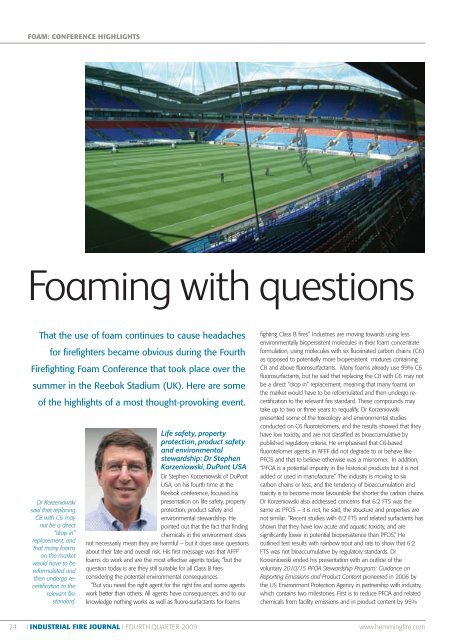
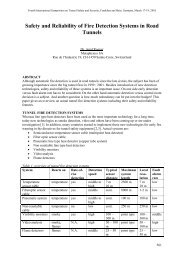
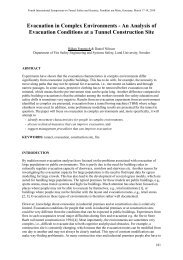

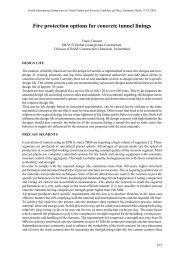
![30-37 TunnelsREV[1]rev.qxd - Industrial Fire Journal](https://img.yumpu.com/22237435/1/184x260/30-37-tunnelsrev1revqxd-industrial-fire-journal.jpg?quality=85)
